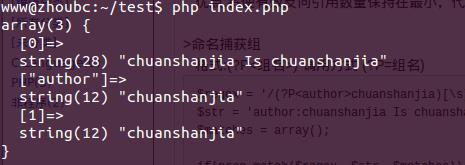PHP的正则表达式
Posted 小疯子
tags:
篇首语:本文由小常识网(cha138.com)小编为大家整理,主要介绍了PHP的正则表达式相关的知识,希望对你有一定的参考价值。
正则表达式,大家在开发中应该是经常用到,现在很多开发语言都有正则表达式的应用,比如javascript,java,.net,php等等,我今天就把我对正则表达式的理解跟大家唠唠,不当之处,请多多指教!
$str = \'http://www.youku.com/show_page/id_ABCDEFG.html\';$matches = array();if(preg_match($regex, $str, $matches)){ var_dump($matches);}echo "\\n"; |
preg_match中的$matches[0]将包含与整个模式匹配的字符串。
使用"#"定界符的代码如下.这个时候对"/"就不转义!
$regex = \'#^http://([\\w.]+)/([\\w]+)/([\\w]+)\\.html$#i\';$str = \'http://www.youku.com/show_page/id_ABCDEFG.html\';$matches = array();if(preg_match($regex, $str, $matches)){ var_dump($matches);}echo "\\n"; |
¤ 修饰符:用于改变正则表达式的行为。
我们看到的(\'/^http:\\/\\/([\\w.]+)\\/([\\w]+)\\/([\\w]+)\\.html/i\')中的最后一个"i"就是修饰符,表示忽略大小写,还有一个我们经常用到的是"x"表示忽略空格。
贡献代码:
$regex = \'/HELLO/\';$str = \'hello word\';$matches = array();if(preg_match($regex, $str, $matches)){ echo \'No i:Valid Successful!\',"\\n";}if(preg_match($regex.\'i\', $str, $matches)){ echo \'YES i:Valid Successful!\',"\\n";} |
¤ 字符域:[\\w]用方括号扩起来的部分就是字符域。
¤ 限定符:如[\\w]{3,5}或者[\\w]*或者[\\w]+这些[\\w]后面的符号都表示限定符。现介绍具体意义。
{3,5}表示3到5个字符。{3,}超过3个字符,{,5}最多5个,{3}三个字符。
* 表示0到多个
+ 表示1到多个。
¤ 脱字符号
^:
> 放在字符域(如:[^\\w])中表示否定(不包括的意思)——“反向选择”
> 放在表达式之前,表示以当前这个字符开始。(/^n/i,表示以n开头)。
注意,我们经常管"\\"叫"跳脱字符"。用于转义一些特殊符号,如".","/"
$regex = \'/(?<=c)d(?=e)/\'; /* d 前面紧跟c, d 后面紧跟e*/$str = \'abcdefgk\';$matches = array();if(preg_match($regex, $str, $matches)){ var_dump($matches);}echo "\\n"; |
否定意义:
$regex = \'/(?<!c)d(?!e)/\'; /* d 前面不紧跟c, d 后面不紧跟e*/$str = \'abcdefgk\';$matches = array();if(preg_match($regex, $str, $matches)){ var_dump($matches);}echo "\\n"; |
$regex = \'/HE(?=L)LO/i\';$str = \'HELLO\';$matches = array();if(preg_match($regex, $str, $matches)){ var_dump($matches);}echo "\\n"; |
打印不出结果!
$regex = \'/HE(?=L)LLO/i\';$str = \'HELLO\';$matches = array();if(preg_match($regex, $str, $matches)){ var_dump($matches);}echo "\\n"; |
能打印出结果!
说明:(?=L)意思是HE后面紧跟一个L字符。但是(?=L)本身不占字符,要与(L)区分,(L)本身占一个字符。
$regex = \'/^(Chuanshanjia)[\\w\\s!]+\\1$/\'; $str = \'Chuanshanjia thank Chuanshanjia\';$matches = array();if(preg_match($regex, $str, $matches)){ var_dump($matches);}echo "\\n"; |
$regex = \'/(?P<author>chuanshanjia)[\\s]Is[\\s](?P=author)/i\';$str = \'author:chuanshanjia Is chuanshanjia\';$matches = array();if(preg_match($regex, $str, $matches)){ var_dump($matches);}echo "\\n"; |
运行结果

惰性匹配(记住:会进行两部操作,请看下面的原理部分)
格式:限定符?
原理:"?":如果前面有限定符,会使用最小的数据。如“*”会取0个,而“+”会取1个,如过是{3,5}会取3个。
先看下面的两个代码:
代码1.
<?php$regex = \'/heL*/i\';$str = \'heLLLLLLLLLLLLLLLL\';if(preg_match($regex, $str, $matches)){ var_dump($matches);}echo "\\n"; |
结果1.

代码2
<?php$regex = \'/heL*?/i\';$str = \'heLLLLLLLLLLLLLLLL\';if(preg_match($regex, $str, $matches)){ var_dump($matches);}echo "\\n"; |
结果2

代码3,使用“+”
<?php$regex = \'/heL+?/i\';$str = \'heLLLLLLLLLLLLLLLL\';if(preg_match($regex, $str, $matches)){ var_dump($matches);}echo "\\n"; |
结果3

代码4,使用{3,5}
<?php$regex = \'/heL{3,10}?/i\';$str = \'heLLLLLLLLLLLLLLLL\';if(preg_match($regex, $str, $matches)){ var_dump($matches);}echo "\\n"; |
结果4

$regex = \'/ ^host=(?<!\\.)([\\d.]+)(?!\\.) (?#主机地址)\\| ([\\w!@#$%^&*()_+\\-]+) (?#用户名)\\| ([\\w!@#$%^&*()_+\\-]+) (?#密码)(?!\\|)$/ix\';$str = \'host=192.168.10.221|root|123456\';$matches = array();if(preg_match($regex, $str, $matches)){ var_dump($matches);}echo "\\n"; |
| 特殊字符 | 解释 |
| * | 0到多次 |
| + | 1到多次还可以写成{1,} |
| ? | 0或1次 |
| . | 匹配除换行符外的所有单个的字符 |
| \\w | [a-zA-Z0-9_] |
| \\s | 空白字符(空格,换行符,回车符)[\\t\\n\\r] |
| \\d | [0-9] |
<?php
$str = "PHP编程";
if (preg_match("/([0-9a-zA-Z\\x{4e00}-\\x{9fa5}]+)/u",$str, $matches)) {
var_dump($matches);
echo "\\n";
}
以上是关于PHP的正则表达式的主要内容,如果未能解决你的问题,请参考以下文章
